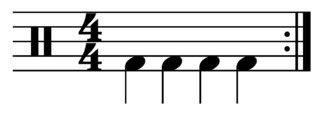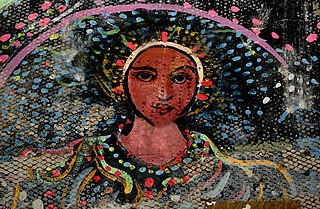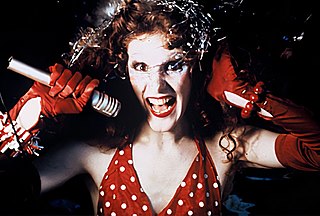Related Research Articles

Disco is a genre of dance music and a subculture that emerged in the 1970s from the United States' urban nightlife scene. Its sound is typified by four-on-the-floor beats, syncopated basslines, string sections, brass and horns, electric piano, synthesizers, and electric rhythm guitars.
No wave was an avant-garde music genre and visual art scene that emerged in the late 1970s in Downtown New York City. The term was a pun based on the rejection of commercial new wave music. Reacting against punk rock's recycling of rock and roll clichés, no wave musicians instead experimented with noise, dissonance, and atonality, as well as non-rock genres like free jazz, funk, and disco. The scene often reflected an abrasive, confrontational, and nihilistic world view.
Chicago house refers to house music produced during the mid to late 1980s within Chicago. The term is generally used to refer to the original house music DJs and producers from the area, such as Ron Hardy and Phuture.

Lawrence Philpot, known as Larry Levan, was an American DJ best known for his decade-long residency at the New York City night club Paradise Garage, which has been described as the prototype of the modern dance club. He developed a cult following who referred to his sets as "Saturday Mass". Influential post-disco DJ François Kevorkian credits Levan with introducing the dub aesthetic into dance music. Along with Kevorkian, Levan experimented with drum machines and synthesizers in his productions and live sets, ushering in an electronic, post-disco sound that presaged the ascendence of house music. He DJ'd at Club Zanzibar in the 1980s as well, home to the Jersey Sound brand of deep house or garage house.

Northern soul is a music and dance movement that emerged in Northern England and the Midlands in the early 1970s. It developed from the British mod scene, based on a particular style of Black American soul music with a heavy beat and fast tempo.

Charles Arthur Russell Jr. was an American cellist, composer, producer, singer, and musician from Iowa, whose work spanned a disparate range of styles. After studying contemporary composition and Indian classical music in California, Russell relocated to New York City in the mid-1970s, where he became involved with both Lower Manhattan's avant-garde community and the city's burgeoning disco scene. His eclectic music was often marked by adventurous production choices and his distinctive voice.

Four-on-the-floor is a rhythm used primarily in dance genres such as disco and electronic dance music. It is a steady, uniformly accented beat in 4
4 time in which the bass drum is hit on every beat . This was popularized in the disco music of the 1970s and the term four-on-the-floor was widely used in that era, since the beat was played with the pedal-operated, drum-kit bass drum.
David Paul Mancuso was an American disc jockey who created the popular "by invitation only" parties in New York City, which later became known as "The Loft". The first party, called "Love Saves The Day", was in 1970.
The Loft was the location for the first underground dance party organized by David Mancuso, on February 14, 1970, in New York City. Since then, the term "The Loft" has come to represent Mancuso's own version of a non-commercial party where no alcohol, food, nor beverages are sold. Mancuso's vision of a private party is similar to, and inspired by, the rent party and house party. Unlike conventional nightclubs or discotheques, attendance is by invitation only. In the late 1970s, Mancuso abandoned the generally accepted and expected practice of beatmatching, preferring to play songs in their entirety on his renowned audiophile-quality sound system. The Village Voice wrote that Mancuso's sound system was the best in New York and even described him as "more of a party engineer than a DJ." Mancuso required that the music played had to be soulful, rhythmic, and impart words of hope, redemption, or pride.
Manuel Parrish is an American songwriter, vocalist and producer. He, along with artists such as Yellow Magic Orchestra, Kraftwerk, Art of Noise, Arthur Baker, Afrika Bambaataa, John Robie, Jellybean Benitez, Lotti Golden, Richard Scher and Aldo Marin, helped create and define electro in the early 1980s.

The Electric Circus was a nightclub located at 19-25 St. Marks Place between Second and Third Avenues in the East Village neighborhood of Manhattan, New York City, from 1967 to August 1971. The club was created by Jerry Brandt, Stanton J. Freeman and their partners and designed by Chermayeff & Geismar. With its invitation to "play games, dress as you like, dance, sit, think, tune in and turn on," and its mix of light shows, music, circus performers and experimental theater, the Electric Circus embodied the wild and creative side of 1960s club culture.
Love of Life Orchestra (LOLO) is an experimental music group formed by Peter Gordon in New York in April 1977. The band is associated with the 1970s New York downtown music scene.
The Gallery was a disco in SoHo, Manhattan which was opened in February 1972 by disc jockey Nicky Siano and his older brother Joe Siano. The first location of The Gallery, located on 132 West 22nd Street, closed in July 1974. It reopened in November 1974 at 172 Mercer and Houston Streets and closed in October 1977. Famed DJs Larry Levan and Frankie Knuckles both worked at the club, but not at the DJ booth. Grace Jones and Loleatta Holloway both made their debut performances at The Gallery.

A nightclub is a club that is open at night, usually for drinking, dancing and other entertainment. Nightclubs often have a bar and discothèque with a dance floor, laser lighting displays, and a stage for live music or a disc jockey (DJ) who mixes recorded music. Nightclubs tend to be smaller than live music venues like theatres and stadiums, with few or no seats for customers.

Wild Combination: A Portrait of Arthur Russell is a documentary film about musician Arthur Russell, directed by Matt Wolf. Released theatrically in 2008, the film was generally well received by critics, winning various awards at international film festivals. Its world premiere was at the Berlin International Film Festival (Panorama), and its theatrical premieres were at the IFC Center in New York and the ICA in London.
Class Action and Phreek were disco and post-disco musical projects. The original Phreek comprised Christine Wiltshire, Leroy Burgess, Patrick Adams, Stan Lucas, Ken Mazur and others. Class Action was directed by Larry Levan and featured Christine Wiltshire as vocalist. Both groups are best known for their club hit "Weekend", written by James Calloway and Leroy Burgess. The 1983 version was remixed by Morales and Munzibai and Larry Levan and produced by Bob Blank and Lola Blank.
Tom Savarese is a DJ best known for his role in the 1970s Disco music scene. He was born on April 26, 1944, in New York City, and grew up in the Bronx neighborhood. He eventually attended Fordham University. Savarese began his career as a DJ in 1969, playing apartment and house parties. Over time he became the full-time first professional Disco DJ in the US, and doing remixes for record labels in NYC. By the late-1970s Savarese was interviewed as an expert in the Disco music scene by major publications, including the New York Times and Billboard Magazine, calling Savarese the "key New York Disco DJ" in 1977. Billboard Magazine named Savarese the New York DJ of the Year that year, as well as national DJ of the year in 1976 and 1977. Savarese' remixes also charted in the top 20 tracks of the New York Daily News Disco charts. The clubs Savarese played during this era included 12 west, and famously turned down the opportunity to become the first DJ to play and hold residence at the club Studio 54. He was also one of the first DJs to play live during New York City fashion runway shows.
Neville G. Pemchekov Warwick (1932–1993) was a modern interpreter of Buddhism and a central figure of the spiritual movement of California during the late 1960s and the 1970s. He made an ancient Japanese Buddhist practice of firewalking popular in the USA.

Ruby and the Rednecks is an American rock band from New York City, inspired by New York Dolls and created by the singer, songwriter, playwright and actress Ruby Lynn Reyner with collaborating musical artists in 1970 and active until today. The band was originally composed by Ruby Lynn Reyner, John Madera, George Basley (drums), Augie Sabini (saxophone), Bobby Kent (drums), Susan Lampert, and Danny Couse, but currently has a new formation. From the original group, only Lampert remains. Ruby wrote most of the lyrics herself. John Madera was praised as a guitar player.
The 2001 Club was a chain of franchised disco nightclubs begun in the Pittsburgh area in 1972 that eventually grew to one of the most successful disco franchises in the country.
References
- ↑ "The golden age of New York clubbing: 'We wanted to be part of something'". The Guardian. November 12, 2016.
- ↑ "Tim Lawrence". University of East London.
- ↑ "Tim Lawrence: Love Saves The Day: A History Of American Dance Music Culture, 1970-79". The A.V. Club. 28 May 2004.
- ↑ "Tome On The Range | Review & Excerpt: Hold On to Your Dreams: Arthur Russell". The Quietus. 16 December 2009.
- ↑ Matos, Michaelangelo (October 9, 2016). "'Life and Death on the New York Dance Floor' Charts a Kinetic Scene in the Early '80s". The New York Times.